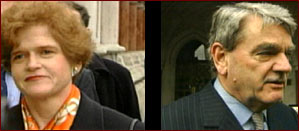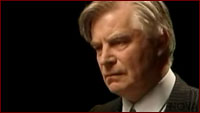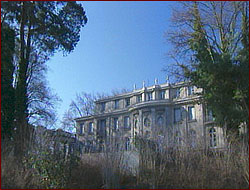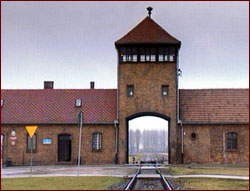
|
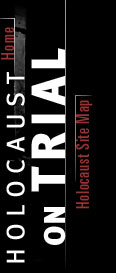
|

But as I learned more about the strange legal confrontation that was already unfolding in room 73 of the High Court in London, I became fascinated. A controversial historian, David Irving, was suing for libel a Jewish-American academic, Deborah Lipstadt, who had accused him of being a distorter of history and a Holocaust denier. Irving was mounting his case alone, without legal support, taking on the legal big guns of a major publisher. The drama of the event was obvious. But it was also clear that the trial would have a significance beyond the specifics of a libel action. It would inevitably involve a detailed re-examination of the Holocaust itself. I had little time to make up my mind about the project. With the trial already in progress, and the obvious need to complete the program as soon as possible, I had to commit within hours. I parked my plans for happier films and got to work.
Since the 1970s, I have made a series of journalistic reconstructions, often about events in eastern Europe, using smuggled transcripts and tape recordings. This enabled me to bring to television stories that were inaccessible to conventional documentary techniques. I had used the form, for example, to make films about the Soviet invasion of Czechoslovakia and the birth of Lech Walesa's "Solidarity" trade-union movement in the Polish shipyards. But I had never before had to grapple with such a torrent of material at such a speed. It would have been impossible without the tireless work of my co-producers Daniel Korn and Mark Radice, who began to familiarize themselves with the daily outpouring of transcripts from the courtroom and to identify the crucial exchanges.
As I sat there, trying to keep a director's eye open for details of personality and mannerism, it was at times hard to take in the unimaginable tragedy that was being quietly explored in an English courtroom. Participants debated documents about the mass slaughter of hundreds of thousands of civilians by Nazi death squads, pursued disagreements about the amount of fuel required to burn thousands of corpses, and so on. At times, Irving clashed with expert witnesses, barely preserving a bitter composure, and the judge on occasion tersely reprimanded him. For all the grotesqueness of his arguments, it was impossible not to be amazed by Irving's determination and staying power as day followed day. And it was equally impossible not to be dismayed, as the head-spinning claims of Holocaust denial collided with the awful realities of the Final Solution. Along with trying to keep up with the trial, I also had to gather other material vital for our program, including the forensic evidence to set alongside the court proceedings. We assembled a team of historians as expert witnesses on various aspects of the Holocaust and interviewed them at length. For me, this involved a crash course in an area of recent history with which I'd had only a layman's knowledge. I came to know the details of the gathering nightmare of the Nazi assault on Europe's Jews, and the extraordinary distortions of the Holocaust deniers.
Alongside keeping up with the trial, interviewing experts, and selecting archival footage, I also had to plan a filming expedition to Germany and Poland. We needed to film at Wannsee, the house near Berlin where Nazi leaders planned the logistics of the Final Solution in January 1942, and at Auschwitz. Almost 60 years later, on a bright sunny morning in a handsome lakeside suburb of Berlin, it was still possible to feel a frisson of recognition in the room where Adolf Eichmann and his fellow Nazi bureaucrats orchestrated the mechanics of genocide. It's a simple museum now, but as author Robert Harris says in our film, "It's a very haunting place. Something has seeped into the brickwork there."
Back in London, I now had to grapple urgently with the job of reconstructing the courtroom exchanges. The trial was moving towards a conclusion, and we wanted to air the film in Britain as soon as possible after the judgment. Production designer Jim Glenn had visited the courtroom several times, and I asked him to build a set that would preserve the geography and style of the court, while locating it against a black limbo background to minimize any distraction.
We filmed the courtroom reconstructions for six days in a London studio. It was intense and uncomfortable work, sometimes testing the limits of the actors' own tolerances as they revisited the ghastly debates between Irving and the expert witnesses about the minutiae of extermination. Sitting in the editing room a few days later, I felt they'd done a remarkable job in conveying the strange reality of what had happened in the courtroom. We had almost completed the program when the judgment against David Irving was announced. Looking back to my initial hesitation about taking on the project, despite all the chilling material I'd had to deal with, and despite the challenging urgency of the schedule, I was very glad that I'd decided to accept the assignment. Like all the really worthwhile programs I've worked on, I reckon it taught me things I needed to know. I only hope it can do the same for the people who see it.
Photos: (7) Courtesy of Leslie Woodhead. The Director's Story | Timeline of Nazi Abuses Results of Death-Camp Experiments: Should They Be Used? Exposing Flawed Science | Resources Transcript | Site Map | Holocaust on Trial Home Editor's Picks | Previous Sites | Join Us/E-mail | TV/Web Schedule About NOVA | Teachers | Site Map | Shop | Jobs | Search | To print PBS Online | NOVA Online | WGBH © | Updated November 2000 |
